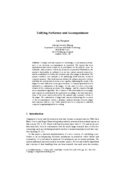“Performing music includes substantial listening skills on part of the performer. Performing with an interactive computer requires the performer to interact with the computer and intuitively and consciously include this information in the responsiveness of his playing. The interaction can be expanded to include the performer’s high-level decisions typical of open-form notation. These decisions can be used for defining and re-defining the computer’s role in the further development of the piece. In this paper I describe how such an open-form notation is used in the interactive man / machine performance environment of my composition ‘GUITAR’ for acoustic guitar and interactive computer. The performance environment functions as a perception-based multi-parameter space where the performer’s score provides means for exploring this space. The open-form notation emphasizes the interactive functionality of the space, and a performance becomes one of many possible explorations of the space.”
In Proceedings of the Second International Symposium on Computer Music Modeling and Retrieval, CMMR 2004. Esbjerg, Denmark, May 26-29 2004. Lecture Notes in Computer Science Volume 3902 / 2006, pp. 149-157. Title: Computer Music Modeling and Retrieval: Second International Symposium, CMMR 2004, Esbjerg, Denmark, May 26-29, 2004. Revised Papers. Editor: Uffe Wiil Kock. Publisher: Springer Verlag Berlin / Heidelberg / New York. ISBN: 3-540-244858-1
